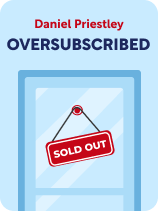

This article is an excerpt from the Shortform book guide to "Oversubscribed" by Daniel Priestley. Shortform has the world's best summaries and analyses of books you should be reading.
Like this article? Sign up for a free trial here.
How can you take advantage of the law of supply and demand? What’s the best way to build brand loyalty?
Serial entrepreneur Daniel Priestley begins his business guide Oversubscribed with an unusual premise: Get more people interested in your product or service than you could possibly serve, and don’t start selling it until that happens. He discusses practical ways that you can generate that interest.
Keep reading for Priestley’s advice on how to create demand for a product (even more than you can meet).
How to Create Demand for a Product
We’ll examine the foundational lesson of Oversubscribed: Attract more customers than you can serve to maximize your profits. We’ll also explore the benefits of word-of-mouth advertising and explain how you can get people talking about your business, as Priestley believes this is the single most effective way to market a product and thus create demand.
(Shortform note: The advice Priestley gives in this book is equally applicable to physical products and services. For brevity’s sake, we’ll refer to these collectively as “products.”)
Let’s explore Priestly’s advice on how to create demand for a product.
The Core Message: Exploit the Law of Supply and Demand
The central idea of Oversubscribed is to maximize your business’s profits by making sure there’s more demand for your product than you can meet.
Priestley explains that the law of supply and demand influences the price of a product—the harder something is to get, the more that thing costs. So, if there’s more demand than supply for a product, you can charge high prices for it, thereby making a significant profit.
(Shortform note: In contrast to Priestley, some business experts believe that the law of supply and demand is becoming outdated. For example, in Exponential Organizations, Salim Ismail says that the most successful modern companies are those that profit from information, a resource with an unlimited supply. Since, in this scenario, the demand can never exceed the supply, a company that profits from information can’t follow Priestley’s advice. However, these companies still manage to turn a profit: Some use personal information to perfectly tailor their products and advertisements to their customers, while others (most notably social media companies) directly gather and sell such information.)
Furthermore, demand breeds demand: people are more likely to want something that’s very popular and hard to get. Therefore, make sure to continue advertising even after customer demand exceeds your supply.
(Shortform note: According to psychology research, wanting what’s hard to get is a common phenomenon. In short, it happens because your brain releases dopamine when you work toward a goal—and the harder that goal is to achieve (in this case, acquiring something that’s hard to get), the more dopamine the brain produces. In other words, scarcity works like a drug; in trying to get something rare, you’re really chasing that dopamine high. By following Priestley’s advice to continue advertising even after demand exceeds supply, you ensure that people continue chasing that dopamine high. Your advertising will further increase demand, making your product even harder to get, thereby increasing people’s cravings for it.)
Build Demand Through Word-of-Mouth
Since the central theme of Oversubscribed is to have more customers than you can handle, a great deal of the book is devoted to methods of attracting those customers.
First of all, Priestley warns that mass marketing strategies like commercials and printed advertisements aren’t as effective as they used to be, largely because people are tired of being advertised to. There are so many companies and products already fighting for people’s attention that mass advertising would turn your product into part of the background noise of modern life, meaning your would-be customers would just tune you out.
(Shortform note: The death of mass marketing has been a theme in business books for quite some time—for example, in Seth Godin’s book Purple Cow (2002), he makes a similar claim that mass marketing strategies don’t work anymore because people are simply overloaded with advertisements. However, many experts disagree with that opinion; some argue that mass marketing is still a key part of an effective marketing strategy because it puts your product in front of as many eyes as possible. Others believe that modern technology like social media will reshape mass marketing and make it more effective than ever, once advertisers perfect information-gathering and targeted advertising techniques.)
Rather than mass marketing, Priestley says that word-of-mouth is the best form of advertisement—in short, people will buy what their friends are buying. In fact, word-of-mouth marketing is more effective than ever because social media allows your customers to advertise your company to their connections quickly and easily.
(Shortform note: Whether or not mass marketing is still effective, some research supports Priestley’s claim that word-of-mouth advertising is more effective. According to Nielsen, one of the biggest names in media research and data collection, over 90% of people trust suggestions from friends and family members more than they trust any other type of advertising. Furthermore, customers who are referred by a family member, friend, or peer (through social media, for instance) spend, on average, twice as much as those who find a company through regular ads.)
The rest of this section will explore different ways to get people talking about your company.
Method 1: Differentiate Yourself
Priestley says that the best way to get people talking about you is to be unusual or remarkable in some way; in other words, find a way to stand out from the crowd and attract people’s attention. Here, we’ll discuss three ways to attract that attention.
First, the most effective way to stand out is to offer something truly unique. Second, if you can’t create a unique product, then you’ll need to give yourself an edge over your competitors. One strategy is to undercut their prices; if you can provide similar products at a lower price than your rivals, people will tend to favor your company. A third way of attracting attention is to offer a product that’s more convenient than the current options.
Method 2: Advertise Your Company, Not Just Your Products
Almost any popular product—no matter how innovative—will soon face competition from imitators and cheap knockoffs. Therefore, you need a customer base that’s loyal to your company, not just to your products.
Priestly says that you can create a market niche and build brand loyalty by carefully designing your company’s image, and he offers a few tips for doing so.
First of all, advertise your company values. Make it clear that your company stands for a good cause and you’ll attract customers who also support that cause. For example, you could advertise that a certain percentage of your profits go toward a particular charity, or that you pay your employees well and encourage a healthy work-life balance.
Second, focus on good customer service. Remember that you’re not just making a sale; you’re building a relationship. You want repeat customers that advertise your company to their friends. Priestley suggests using customer surveys to gauge the strength of your customer service and learn what you could improve.
| In Other Words: Build a Tribe In this section, Priestley is suggesting that you create what Seth Godin calls a tribe around your new company. In Tribes, Godin explains that a tribe is a particular type of social group whose members have three things in common: • A leader. In this case, you’re the leader—as the head of your company, you’re the one guiding the group’s interests and actions. • A shared belief. A tribe forms around a shared belief and is motivated by that belief. This is why advertising your company values is so important: You’ll form a tribe of people who share your values and who therefore support your company as a means of promoting those values. • Connections to the rest of the group. This should happen naturally; people who support the same company and buy the same products will discuss their shared experiences and build interpersonal relationships as a result. This is also why you want to focus on good customer service—you want the experiences people share with each other to be positive so that your company has a good reputation. Elon Musk is an example of someone who built a tribe. In his prime, Musk had millions of fans who shared his vision of the future (the belief) and trusted him (the leader) to make that vision a reality. In fact, Musk’s tribe is so strong that he still has numerous die-hard supporters even after his recent apparent missteps with Twitter. |

———End of Preview———
Like what you just read? Read the rest of the world's best book summary and analysis of Daniel Priestley's "Oversubscribed" at Shortform.
Here's what you'll find in our full Oversubscribed summary:
- Why you should build demand for your product before you even release it
- How to run a successful marketing campaign
- Why word-of-mouth advertising is more effective than mass marketing






